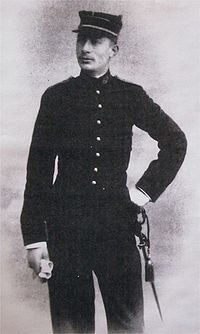
Ernest Duchesne
Encyclopedia

Alexander Fleming
Sir Alexander Fleming was a Scottish biologist and pharmacologist. He wrote many articles on bacteriology, immunology, and chemotherapy...
discovered the antibiotic
Antibiotic
An antibacterial is a compound or substance that kills or slows down the growth of bacteria.The term is often used synonymously with the term antibiotic; today, however, with increased knowledge of the causative agents of various infectious diseases, antibiotic has come to denote a broader range of...
properties of penicillin
Penicillin
Penicillin is a group of antibiotics derived from Penicillium fungi. They include penicillin G, procaine penicillin, benzathine penicillin, and penicillin V....
, a substance derived from those moulds, but his research went unnoticed.
Life and work
Duchesne entered l'Ecole du Service de Santé Militaire de Lyon (the Military Health Service School of Lyons) in 1894. Duchesne's thesis, “Contribution à l’étude de la concurrence vitale chez les micro-organismes: antagonisme entre les moisissures et les microbes” (Contribution to the study of vital competition in micro-organisms: antagonism between moulds and microbes), that he submitted in 1897 to get his doctorate degree, was the first study to consider the therapeutic capabilities of moulds resulting from their anti-microbial activitya.Duchesne had made his breakthrough by observing how the Arab stable boys at the army hospital kept their saddles in a dark and damp room to encourage mould to grow on them. When he asked why, they told him that the mould helped to heal the saddle sores on the horses. Intrigued, Duchesne prepared a solution of the mould and injected it into a series of diseased guinea pigs. All recovered.
In a series of meticulous experiments, Duchesne studied the interaction between Escherichia coli
Escherichia coli
Escherichia coli is a Gram-negative, rod-shaped bacterium that is commonly found in the lower intestine of warm-blooded organisms . Most E. coli strains are harmless, but some serotypes can cause serious food poisoning in humans, and are occasionally responsible for product recalls...
and Penicillium glaucum
Penicillium
Penicillium is a genus of ascomycetous fungi of major importance in the natural environment as well as food and drug production. Members of the genus produce penicillin, a molecule that is used as an antibiotic, which kills or stops the growth of certain kinds of bacteria inside the body...
, showing that the latter was able to completely eliminate the former in a culture containing only these two organisms. He also showed that an animal inoculated with a normally lethal dose of typhoid bacilli would be free of the disease if the animal was also inoculated with Penicillium glaucum
Penicillium
Penicillium is a genus of ascomycetous fungi of major importance in the natural environment as well as food and drug production. Members of the genus produce penicillin, a molecule that is used as an antibiotic, which kills or stops the growth of certain kinds of bacteria inside the body...
. This contrasts with the strain discovered by Fleming, Penicillium notatum, which did not affect the typhoid bacilli.
Because he was 23 and unknown, the Institut Pasteur
Pasteur Institute
The Pasteur Institute is a French non-profit private foundation dedicated to the study of biology, micro-organisms, diseases, and vaccines. It is named after Louis Pasteur, who made some of the greatest breakthroughs in modern medicine at the time, including pasteurization and vaccines for anthrax...
did not even acknowledge receipt of his dissertation. He urged more research but unfortunately his army service after getting his degree prevented him from doing any further work.
Duchesne served a one year internship at Val-de-Grâce
Val-de-Grâce
This article describes the hospital and former abbey. For the main article on Mansart and Lemercier's central church, see Church of the Val-de-Grâce....
before he was appointed a 2nd class Major of Medicine in the 2nd Regiment de Hussards de Senlis. In 1901, he married Rosa Lassalas from Cannes
Cannes
Cannes is one of the best-known cities of the French Riviera, a busy tourist destination and host of the annual Cannes Film Festival. It is a Commune of France in the Alpes-Maritimes department....
. She died 2 years later of tuberculosis
Tuberculosis
Tuberculosis, MTB, or TB is a common, and in many cases lethal, infectious disease caused by various strains of mycobacteria, usually Mycobacterium tuberculosis. Tuberculosis usually attacks the lungs but can also affect other parts of the body...
. In 1904, Duchesne also contracted a serious chest disease, probably tuberculosis. Three years later, he was discharged from the army and sent to a sanatorium in Amélie-les-Bains. He died 12 April 1912, at age 37. Duchesne is buried next to his wife in the Cimetière du Grand Jas
Cimetière du Grand Jas
The Cimetière du Grand Jas is located at 205 avenue de Grasse in Cannes on the French Riviera. The nine hectare terraced cemetery began operations in 1866 and is known for its landscaped architecture with rich floral decorations and statuary.Its "English square" or Cimetière Anglais, is the final...
in Cannes.
Recognition
Duchesne was posthumously honoured in 1949, 5 years after Alexander FlemingAlexander Fleming
Sir Alexander Fleming was a Scottish biologist and pharmacologist. He wrote many articles on bacteriology, immunology, and chemotherapy...
had received the Nobel Prize.
A history of antibiotics contains a suggestion on why it was forgotten:
- While Fleming generally receives credit for discovering penicillin, in fact technically Fleming rediscovered the substance. In 1896, the French medical student Ernest Duchesne originally discovered the antibiotic properties of Penicillium, but failed to report a connection between the fungus and a substance that had antibacterial properties, and Penicillium was forgotten in the scientific community until Fleming's rediscovery.

